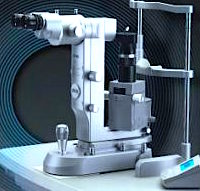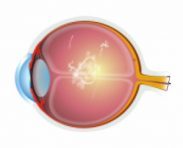If floaters are getting in the way of your vision, there is a solution.

Laser treatment can clear floaters from your vision.
Laser Treatment for Floaters is now available at Moran Eye Associates. This painless, in-office procedure, can remove and reduce floaters from your vision. It is covered by most medical insurances.
The goal of this treatment, known as Vitreolysis, is to achieve a functional improvement so that you can return to day-to-day activities without the hindrance of floaters.
What happens during the procedure?
In an exam room using the YAG Laser pictured above, Dr. Moran will apply laser light to evaporate the floaters. The laser pulses convert the floater molecules into a gas, removing or reducing the floater so that it no longer disturbs your vision.
Before the procedure, your eye will be numbed with anesthetic drops. Then, a contact lens will be placed on your eye so that Dr. Moran can clearly see inside your eye while looking through a special microscope.
During treatment, you may notice small, dark specks or shadows. The laser will make a clicking sound as the pulses of light are applied. Each treatment session will take about 20-30 minutes, and it may take two, or possibly three sessions, in order to achieve the best result.
Are you a candidate for Laser Floater Treatment?

Dilated Eye
Before you schedule the laser procedure, Dr. Moran will need to see you for a dilated evaluation to determine your eligibility for vitreolysis treatment.
Considerations include your age, how long you have had the floaters, and the characteristics of the floaters themselves.
Are there different types of Floaters?
Yes. Floaters are the small pieces of debris that float in the vitreous (clear fluid) of the eye. Floaters can appear long and stringy, cloud-like or round.

Cobweb Floaters
Fibrous Strand Floater: Most common in young people, this thin, dense floater can appear as dots, or stringy cobwebs, which are a result of clumping of the collagen in the eye. Depending on the size and location of this floater, it may be treatable with vitreolysis.

Cloud-Like Floaters
Diffuse Floaters: This cloud-like type of floater is caused by the natural aging of the eye. Due to the scattered, wide-spread nature of this floater, it may require multiple treatments for best results.

Weiss Ring Floater

Weiss Ring Floater: This large, ring-shaped floater is located safely away from the lens and the retina, which makes it a good candidate for this procedure.
If you have more questions about this procedure, set up an appointment for an evaluation to see if we can make your vision floater-free 610-628-2022.
